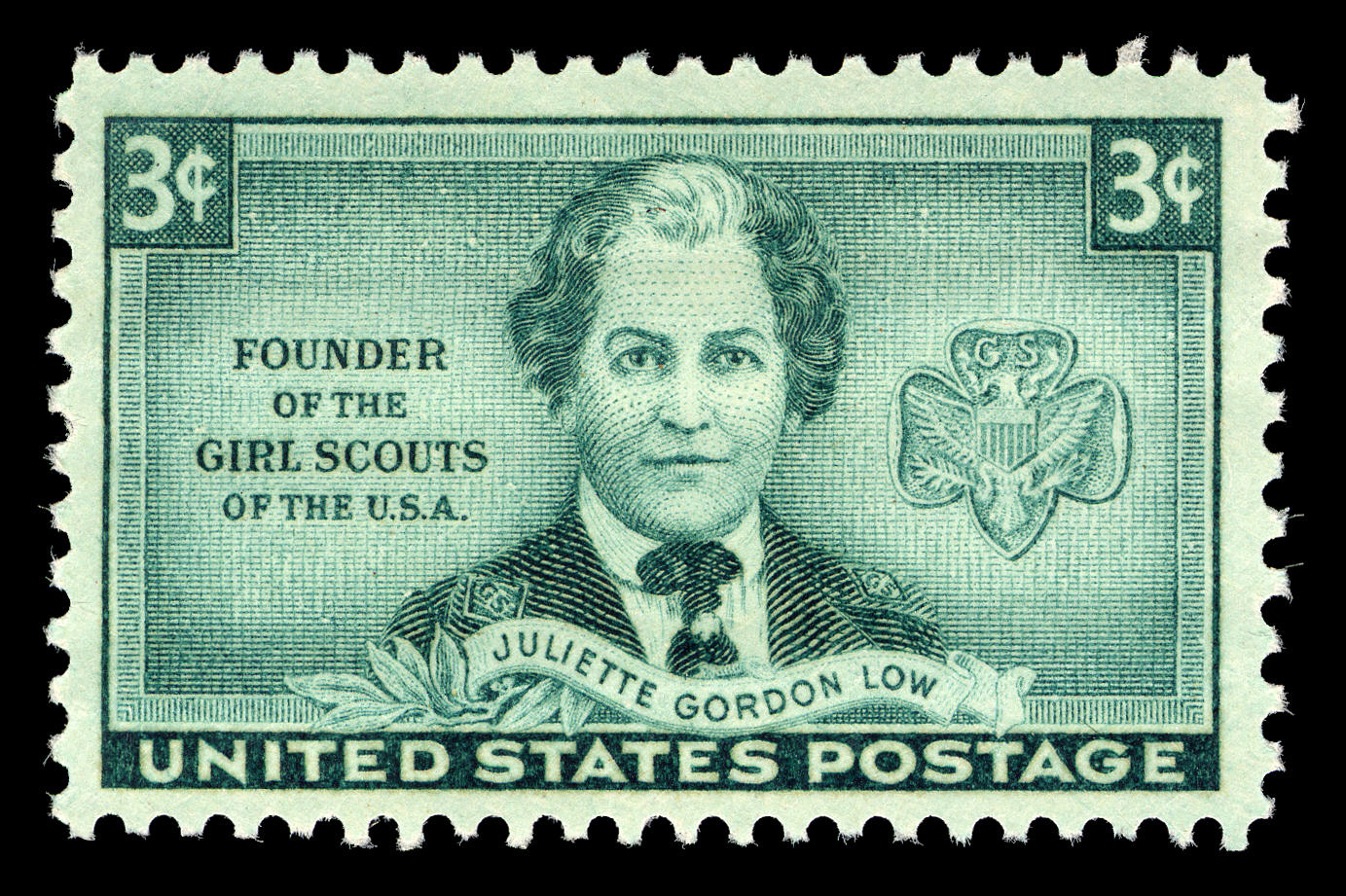
A patent for girls’ empowerment
Juliette Gordon Low founded the Girl Scouts of the USA and patented the organization’s iconic trefoil badge in 1914. A three-leafed clover design adapted from the Boy Scouts’ similar badge, Low’s trefoil suggested a fundamental equality between girls and boys on the eve of women’s suffrage and continues to signal girls’ invaluable contributions to American life and culture.
12 min read
Each month, our Journeys of Innovation series tells the stories of inventors or entrepreneurs who have made a positive difference in the world. This month’s story focuses on the journey of the founder of the Girl Scouts of the USA.
“I’ve got something for the girls of Savannah and all America, and we’re going to start it tonight,” Juliette Gordon Low told her cousin Nina during a telephone call one day in February 1912. “Come right over,” Low insisted. She was about to change millions of lives.
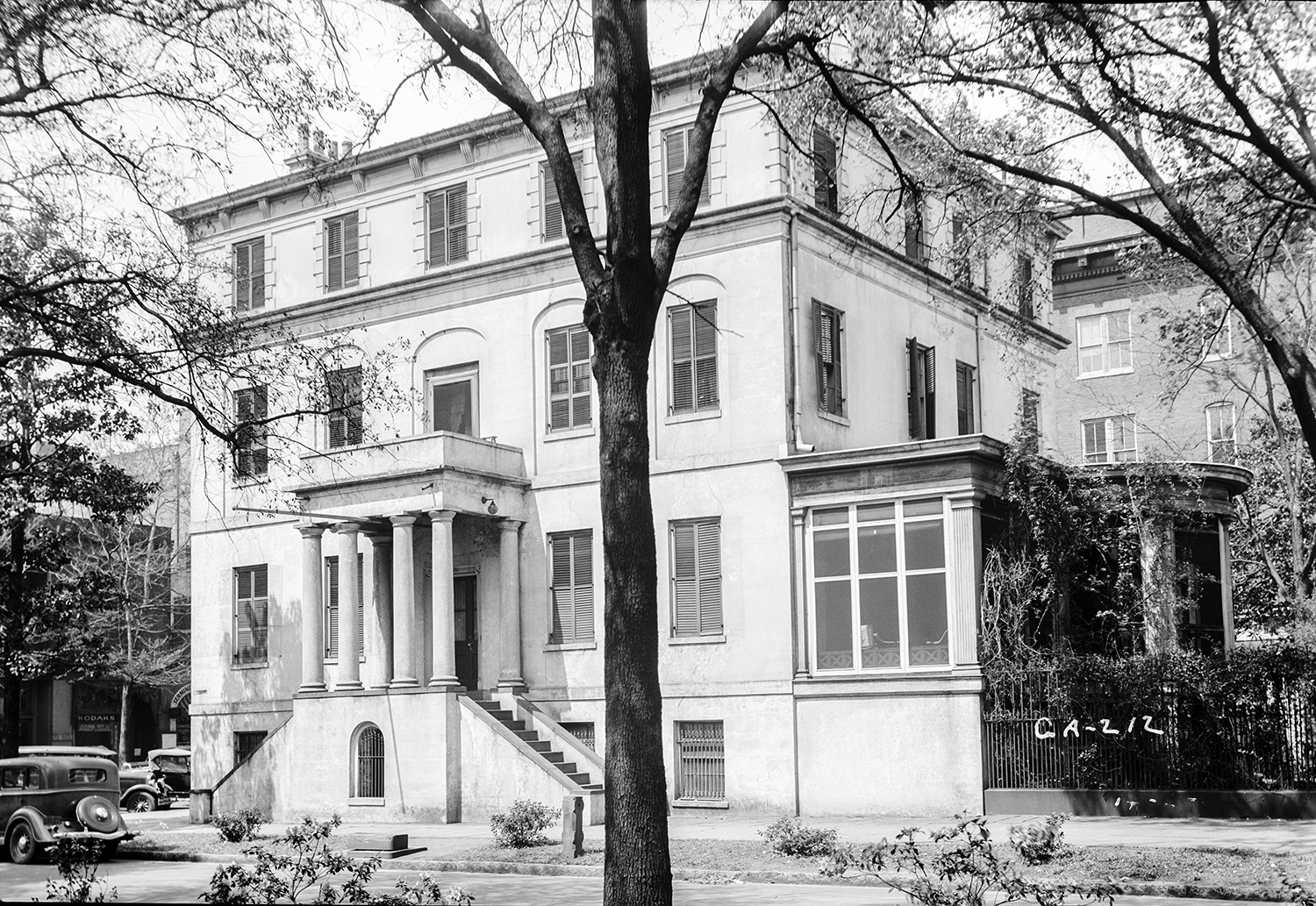
Juliette Gordon Low was born at 10 East Oglethorpe Avenue in Savannah, Georgia, on October 31, 1860. The property’s carriage house (not pictured) became the U.S. Girl Guides’ first headquarters in 1912. Collection of the Library of Congress.
In a matter of days, Low formed the first American troop of Girl Guides, the sister organization to the Boy Scouts, both of British origin. Thus began the process by which Low adapted, expanded, and transformed the Girl Guides into the Girl Scouts, a lasting and quintessentially American institution. At the same time, Low took pains to create and protect the Girl Scouts brand by obtaining a design patent for the trefoil badge and then using the design wherever she could—in print, on uniforms, and at ceremonies. More than a century later, the Girl Scouts organization still uses the design as a trademark for badges, pins, logos, and—most deliciously—the shape of the shortbread cookies called Trefoils, on sale every spring.
Low actually obtained three patents over the course of her life (1860-1927). One was for a disposable drinking cup, another for a disposable garbage can liner, but the most famous by far is the design patent for the Girl Scouts’ trefoil badge. Low’s path from girlhood and marriage to the Girl Scouts had many twists, turns, surprises, and setbacks in a tumultuous period spanning the U.S. Civil War and World War I, both of which Low experienced firsthand.
Juliette “Daisy” Gordon was born in Savannah, Georgia, on October 31, 1860, just before the start of the Civil War, and grew up in a large family—six children in all. One of her brothers, Arthur, described Low as “killingly funny,” if not always on purpose. He and the others soon took to calling her “Crazy Daisy” on account of her goodhearted scheming, playful creativity, and endearing clumsiness. To smooth away some of these edges, and in keeping with a commitment to education, Low’s parents sent her to various boarding and finishing schools.
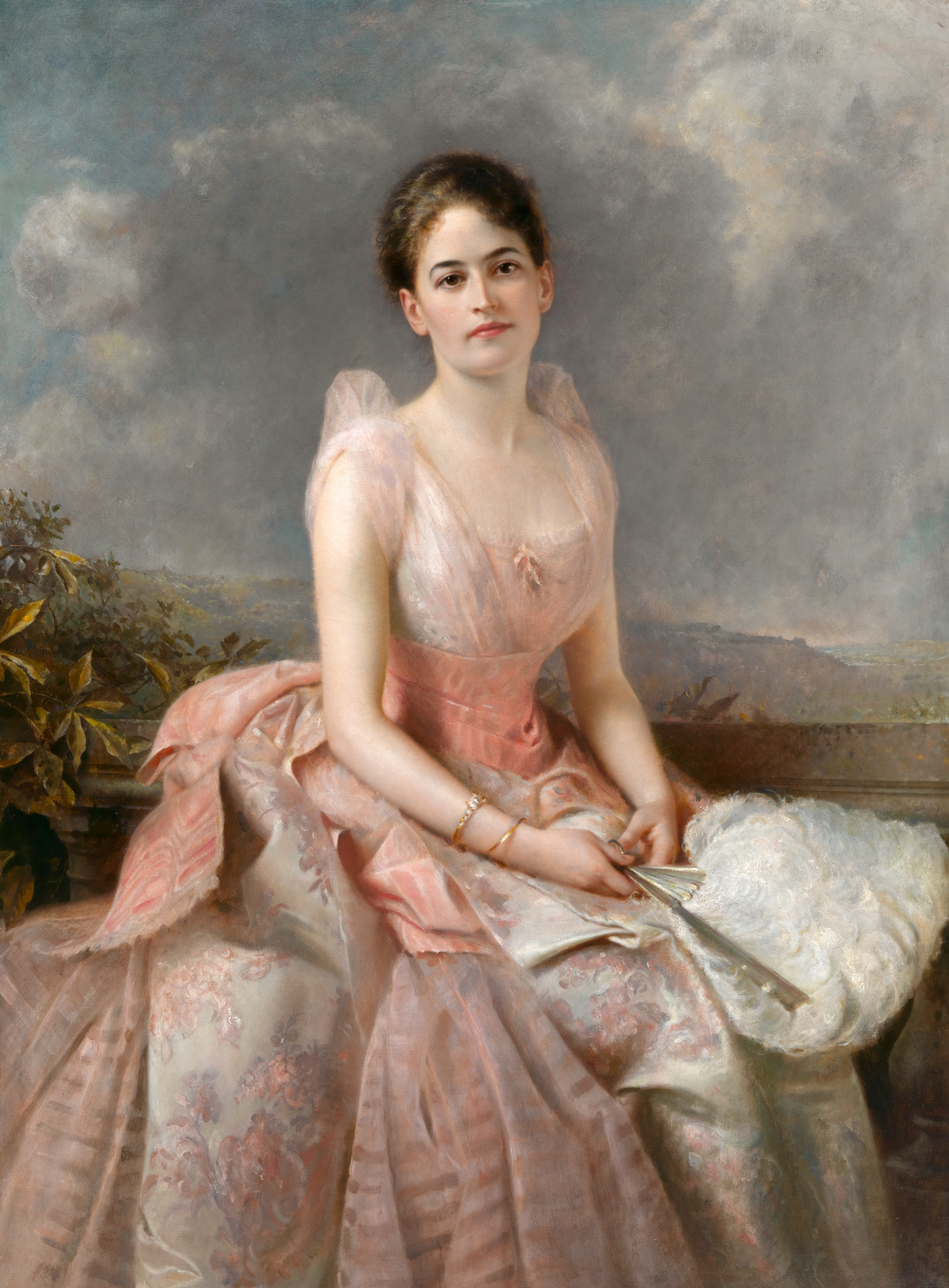
Around the time of her marriage, Juliette Gordon Low sat for a portrait (1887) by the British artist Edward Hughes, who also painted royalty. His portrait of Queen Mary (1867-1953) still hangs in the vestibule of Buckingham Palace. Collection of the National Portrait Gallery, Washington, D.C.
After her return to Savannah from the last such institution, Low met and fell in love with William “Willy” Mackay Low, a Savannah-born expatriate resident in England and heir to a multimillion-dollar fortune. Around the same time, a botched medical procedure resulted in permanent damage to Daisy’s hearing and health. As a cure for what was probably a severe ear infection, Daisy’s doctor applied silver nitrate—a caustic chemical—directly to the ear canal, which inflicted excruciating pain and necessitated weeks of recuperation. These medical misfortunes did not stop her and Willy from trying for years to get their parents to consent to their marriage. The main obstacle was Daisy’s father, who saw in Willy an aristocratic playboy rather than an upstanding gentleman. Nevertheless, Daisy married Willy in 1886. The couple settled in England the following year and eventually purchased a stately country home in Warwickshire.
The marriage was a disaster. Willy spent months away from home, carousing with the Prince of Wales and others, gambling and flirting, until he abandoned Daisy for another woman around 1900. “I fear Willy is quite under Mrs. Bateman’s influence,” Daisy wrote to her father in 1901, “and has made up his mind to chuck me.” Against the morals and expectations of her class and period, Daisy chose a radical step: divorce. Yet before the details could be finalized, Willy died, leaving his money to Mrs. Bateman. On Daisy’s behalf, Willy’s sisters contested the will and succeeded, ensuring for Daisy the income necessary to maintain a very comfortable life—if not, under the circumstances, an exceptionally easy one.
The story of a fashionable lady scorned, widowed, and then vindicated in this way might give an impression of Daisy Low as a passive subject to events. But her correspondence and the rest of the written record, uncovered and analyzed in vivid detail by Low’s biographer Stacy A. Cordery, conjure a woman of action, ingenuity, and vision.
From her childhood in the 1860s and ‘70s to the death of her estranged husband in 1905, Low pursued interests and activities unusual for a woman of her period and class. Childhood arts and crafts projects, a brief period of formal study in painting, and self-directed tuition in wood- and metalworking reveal Low’s early and sustained attention to the arts and the cultivation of her creative faculties—both of which would become Girl Scout imperatives later on. The willingness to band together with other girls for charitable service appears early, too, in the form of the “Helpful Hands Club,” which Low formed around the age of 12 to aid an immigrant family in the neighborhood. She also performed civic service during the Spanish-American War, caring for sick and wounded soldiers in a disease-ridden military encampment. Through all of this, Low tended to her friendships, another mainstay of Girl Scouting, and used community service to lend meaning and a higher purpose to relationships. She even established a pattern of communing with nature and caring for animals; dogs, mockingbirds, parrots, and at least one needy turtle found a loving home with Low. These interests and activities eventually became integral parts of Girl Scouting and the Girl Scout ethos.
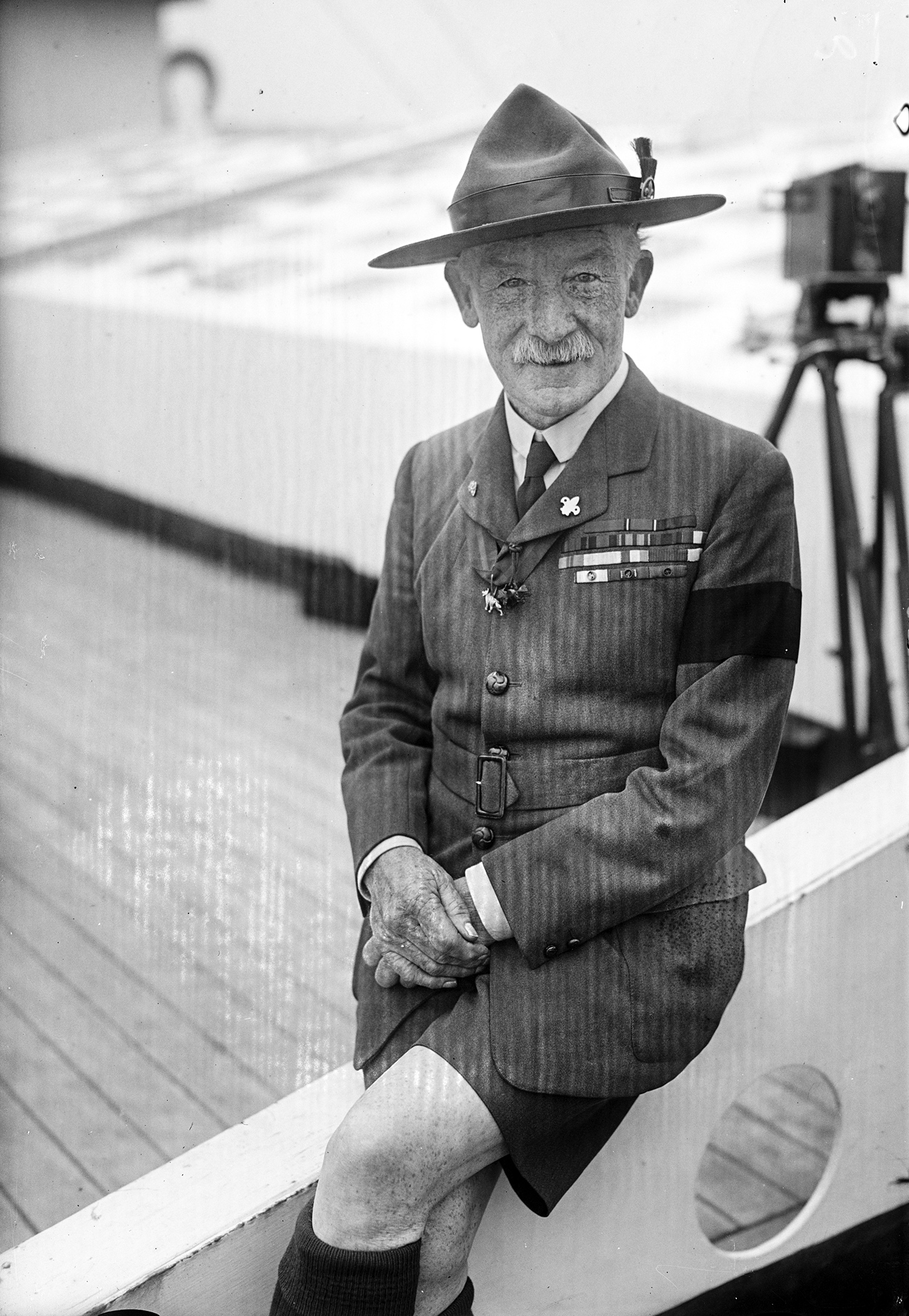
Robert Baden-Powell, photographed here around 1900, founded the Boy Scout Association and became a close personal friend of Juliette Gordon Low. Collection of the Library of Congress.
The history of the Girl Scouts, and of Low’s ascent to national and then international fame, began at a luncheon in 1911, when she found herself seated next to Robert Baden-Powell, the British hero of the Boer War (1899-1902) and founder of the Boy Scouts. From him, Low learned of the Boy Scouts’ sister organization, the Girl Guides, and after Baden-Powell’s invitation to Low to get involved, she wrote to a friend of feeling “a sort of intuition” that “a more useful sphere of work might open up” if only she “followed” Baden-Powell’s “ideas.” Through her friendship with Baden-Powell and her activities over the next several years, Low proved that she could go further than simply following the British example. Instead, she created scouting anew.
The process began modestly enough with Low’s own Girl Guides group at the country residence she rented in Scotland. The girls learned the basics of reading maps, tying knots, and spinning yarn, among other pursuits. A close friend observed that Low, since the formation of her Girl Guides group, looked better and happier than ever.
Early in 1912, Baden-Powell and Low crossed the Atlantic—Baden-Powell to integrate British and American scouting under one transatlantic organization, Low to start the first Girl Guides group in the United States. At Low’s instigation, the first U.S. Girl Guides induction ceremony took place in Savannah almost immediately. The carriage house of her childhood home served as a headquarters and classroom, where outside experts gave the first American Girl Guides lessons in life skills and first aid. Drilling and sports—basketball, in fact—happened outside.
In addition to basketball, there were other signs of the Americanization of the Girl Guides. In the summer of 1912, Low’s copy of the British handbook “How Girls Can Help to Build Up the Empire” arrived, and she set to work adapting it to American sensibilities. The stateside version, “How Girls Can Help Their Country,” appeared in short order. At the same time, Low worked to introduce the Girl Guides to elite networks of patronage, the hope being that high-profile support for the organization would help it grow. When President Taft stopped at the Gordon home in Savannah in late 1912, Low pitched the Girl Guides as a good charity for Taft’s daughter to promote publicly.
Low’s early efforts at winning support from American elites were not always fruitful. For one thing, Girl Guiding was a difficult sell in 1912, when the sight of enterprising, uniformed young women in public was still controversial. A more pressing concern for Low was that many potential supporters of Girl Guiding had already cast their lot with competing organizations: the Camp Fire Girls, the Girl Pioneers, and the so-called “Girl Scouts of America,” an Iowa-based association that had formed without official sanction from Baden-Powell.
Low used her close friendship with Baden-Powell and her talent for networking to gain an advantage over the competing organizations. So trusting was Baden-Powell of her judgment that he even allowed Low to re-designate her “Guides” as “Scouts” in 1913. To reinforce the connection with Baden-Powell’s Boy Scouts, Low had the Girl Scouts’ uniforms switched from blue to khaki. Meanwhile, the new Girl Scouts organization established a national network and an official headquarters in Washington, D.C.
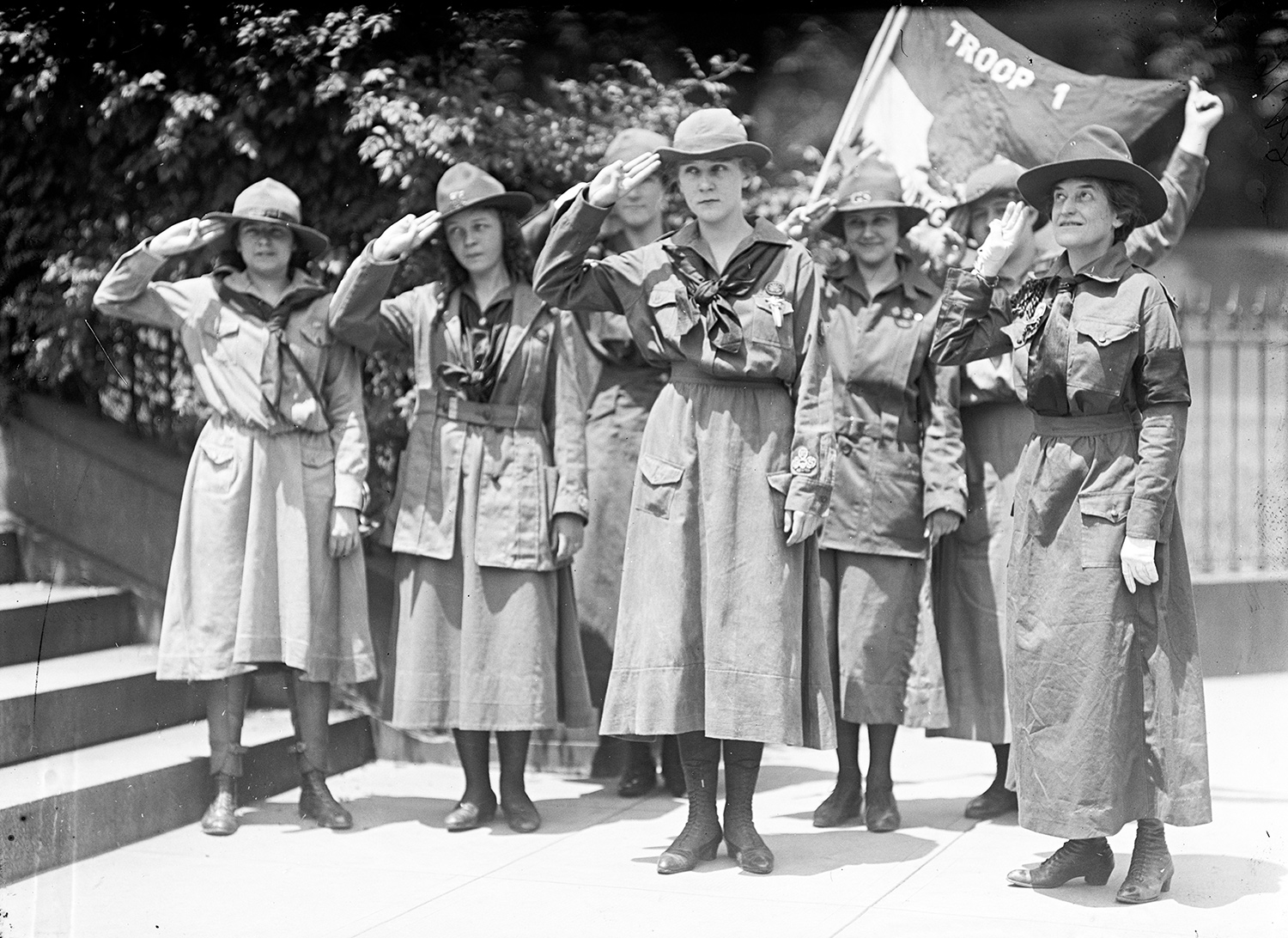
The first troop of Girl Scouts convenes for a photograph, ca. 1917. Juliette Gordon Low stands at the far right. Collection of the Library of Congress.
Low’s trefoil badge (U.S. Design Patent No. 45,234, issued February 10, 1914), based on the Boy Scouts' similar badge, was the linchpin of this process, a sign of the deep association between Baden-Powell’s Boy Scouts and Low’s Girl Scouts. An explanation of the meaning of the trefoil, printed in the 1916 edition of the Girl Scouts handbook, describes the design as a “clover leaf, the three leaves representing the Girl Scout Promises: (1) to do her duty to God and her country, (2) to help other people at all times, (3) to obey the Scout law.” A prescription for how Girl Scout inductees should conduct themselves, the explanation of the trefoil’s meaning also works like a summary of Low’s life’s work and values, the culmination of a decades-long effort to find a public, productive role for herself and other women in the early stages of women’s enfranchisement and attainment of social, economic, political, and legal equality.
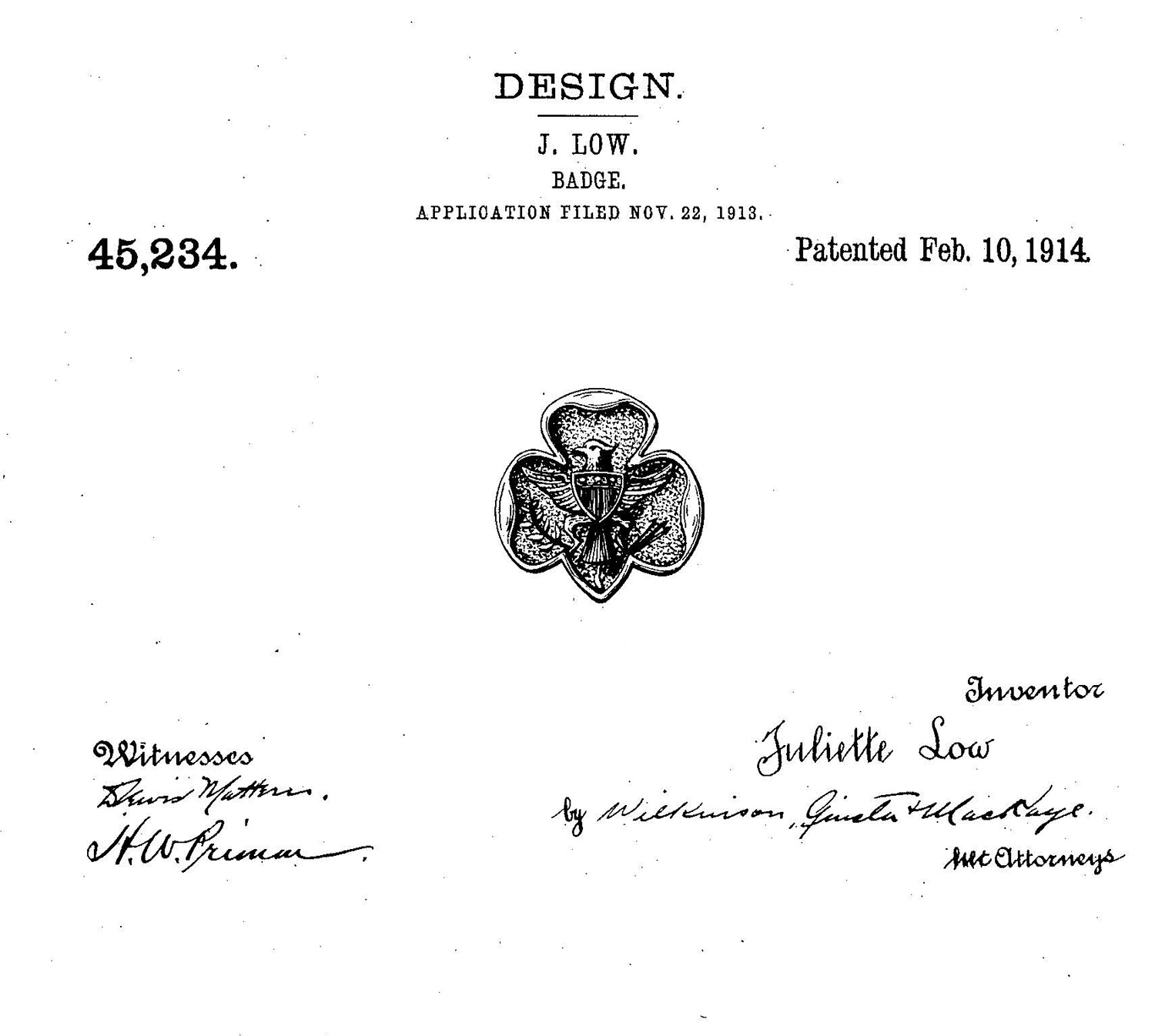
Juliette Gordon Low received U.S. Design Patent No. 45,234 on February 10, 1914. The drawing she submitted reflects the Girl Scouts’ British roots (Low had borrowed the trefoil shape from Robert Baden-Powell’s Boy Scouts) but with an American twist: the bald eagle from the Great Seal of the United States.
The trefoil, worn as a badge by Girl Scouts in and out of uniform, signaled immediately and wordlessly that girls now had the opportunities for fun and service previously available only to boys. This was a bid for gender equality that distinguished the Girl Scouts from its competitors, who stressed the differences between girls and boys and the subordination of the former to the latter, and enhanced its appeal. Membership exploded.
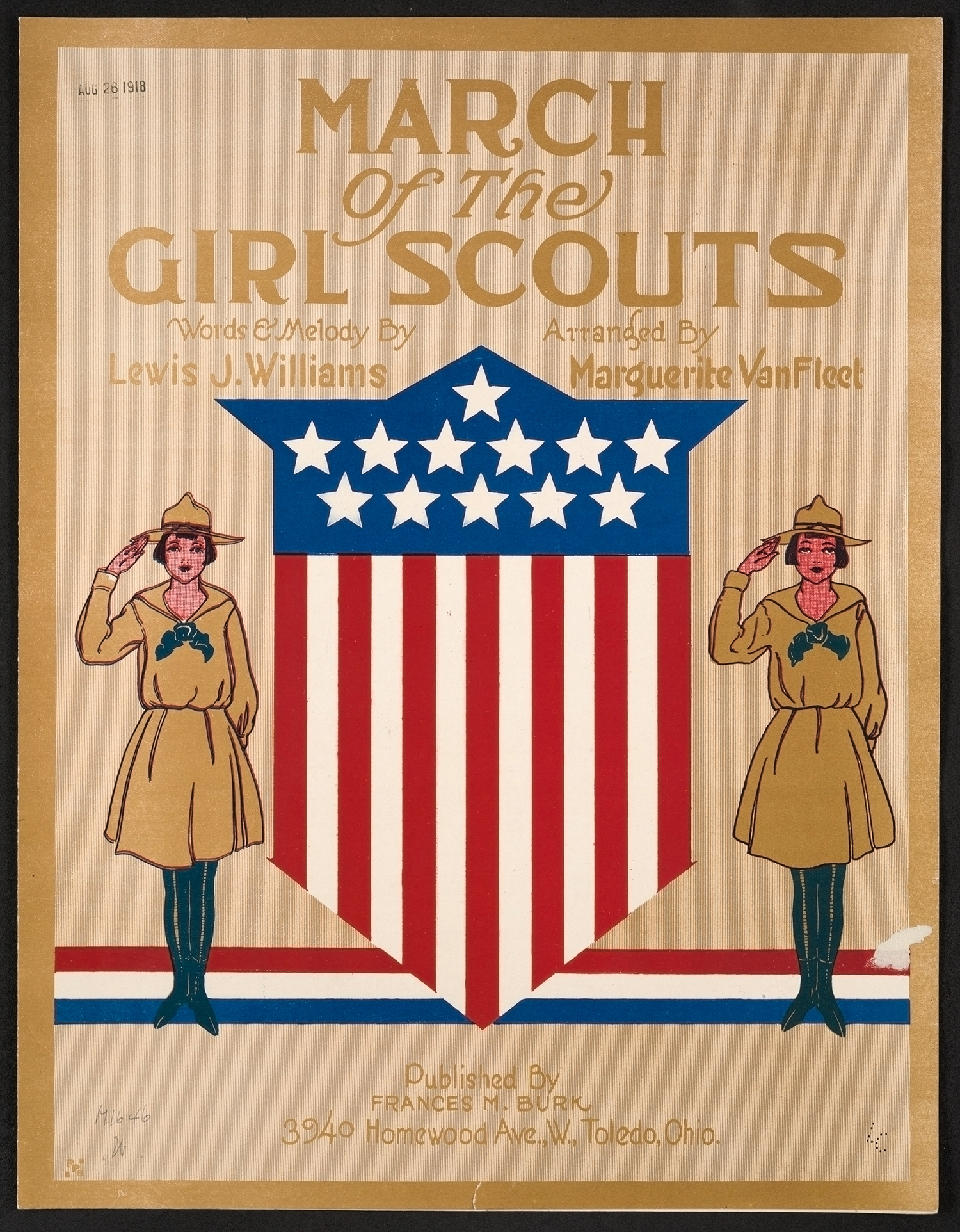
This 1918 publication (sheet music) trades on the Girl Scouts’ energetic, high-profile contributions to the war effort. Collection of the Library of Congress.
After World War I, which brought the Girl Scouts to national attention through cooperative relationships with the Red Cross, the U.S. Food Administration, and other institutions involved in the war effort at home and abroad, Girl Scout membership reached 100,000. Low continued to travel back and forth between the United Kingdom and the United States, forging new bonds and strengthening old ones, all in the service of the growth of the organization. And she increasingly stepped away from day-to-day operations, which by 1919 were being handled by a cadre of professional officers.
Busy with the work of promoting the Girl Scouts across the United States and abroad, and suffering from intermittent health problems, Low needed to relinquish her presidency, but what would her new role be? The answer was easy enough: “Founder” became a permanent, alternative title to “President” that pleased all parties. The thornier issue was the problem of Low’s intellectual property. By virtue of her having patented it, she owned the rights to the trefoil badge and controlled its reproduction and distribution.
Here, Low and the Girl Scouts’ new leadership struck a deal. So long as Low, in perpetuity, was recognized in print and public statements as the organization’s founder, then the Girl Scouts could own the rights to and use the trefoil. Low’s brother drew up the necessary legal document, and ownership transferred in 1921. With this agreement, Low ensured the immortality of her design and her memory.
The trefoil appeared in Girl Scout publications throughout the 1920s and on boxes of Girl Scout cookies by the 1930s. In 1935, the Girl Scout Federation of Greater New York went a step further with Low’s design by purchasing a trefoil-shaped die for cutting cookie dough. Soon, the national Girl Scouts organization licensed commercial bakers to make the Trefoil cookie. It has since become an American classic. And still today, more than 100 years after Low received her patent, Girl Scouts proudly wear trefoil badges on their uniforms as symbols of a commitment to the organization’s values and mission.
Credits
Produced by the USPTO’s Office of the Chief Communications Officer. For feedback or questions, please contact inventorstories@uspto.gov.
Direct quotations of Juliette Gordon Low come from Stacy A. Cordery’s biography “Juliette Gordon Low: The Remarkable Founder of the Girl Scouts” (New York: Penguin, 2013). The postage stamp (1948) depicting Juliette Gordon Low and the trefoil badge she patented in 1914 are courtesy of the Smithsonian’s National Postal Museum.
References
Cordery, Stacy A., “Juliette Gordon Low, Inventor,” StacyCordery.com, January 28, 2011, www.stacycordery.com/juliette-gordon-low/juliette-gordon-low-inventor/.
Cordery, Stacy A., “Juliette Gordon Low: The Remarkable Founder of the Girl Scouts” (New York: Penguin, 2013), ix-xi, 29, 33-36, 40-48, 51-65, 83-113, 117-19, 122-24, 132-34, 144-49, 151-68, 175, 179-226, 230-66, 275, 280, 290, 294.
Cordery, Stacy A., “What Happened to the Trefoil Patent?” StacyCordery.com, February 3, 2012, www.stacycordery.com/juliette-gordon-low/what-happened-to-the-trefoil-patent/.
“Edward Hughes (1832-1908), Queen Mary (1867-1953) when Victoria Mary, Duchess of York,” Royal Collection Trust, accessed January 4, 2021, www.rct.uk/collection/405365/queen-mary-1867-1953-when-victoria-mary-duchess-of-york.
Girl Scouts of the USA, “Girl Scout Cookie History: An Icon of American Culture,” accessed January 27, 2021, www.girlscouts.org/en/cookies/all-about-cookies/Cookie-History.html.
Kimmel, Michael S., “Men’s Responses to Feminism at the Turn of the Century,” Gender and Society 1 (1987): 261-83.
Lawson, Katheryn, “Girl Scout Contrafacta and Symbolic Soldiering in the Great War,” American Music 35 (2017): 375-411.
Low, Juliette Gordon, “Girl Scouts as an Educational Force,” Bulletin, 1919, no. 88, Department of the Interior, Bureau of Education (Washington, D.C.: Government Printing Office, 1919), 677-82.
Low, Juliette Gordon, ed., “How Girls Can Help Their Country,” adapted from Agnes Baden-Powell and Sir Robert Baden-Powell’s Handbook (n.p., 1916), 28-29.
Paris, Leslie, “The Adventures of Peanut and Bo: Summer Camps and Early-Twentieth-Century American Girlhood,” Journal of Women’s History 12 (2001): 47-76.
Peters, Sarah L., “‘Moon Lake’ and the American Summer Camp Movement,” Eudora Welty Review 6 (2014): 55-67.
Spring, Kelly A., “Juliette Gordon Low (1860-1927),” National Women’s History Museum, accessed December 7, 2020, www.womenshistory.org/education-resources/biographies/juliette-gordon-low.
Swetnam, Susan H., “Look Wider Still: The Subversive Nature of Girl Scouting in the 1950s,” Frontiers 37 (2016): 90-114.
Tedesco, Laureen, “Progressive Era Girl Scouts and the Immigrant: ‘Scouting for Girls’ (1920) as a Handbook for American Girlhood,” Children’s Literature Association Quarterly 31 (2006): 346-68.



